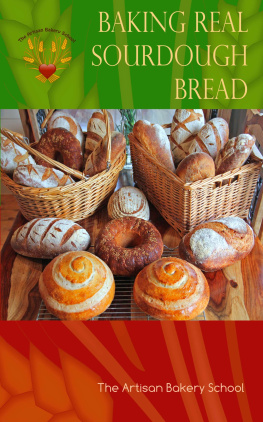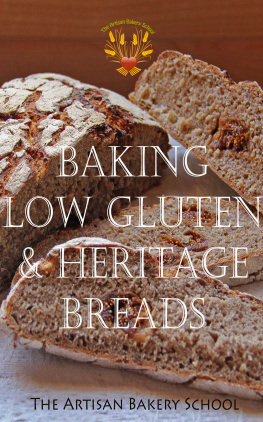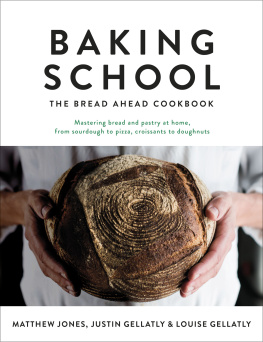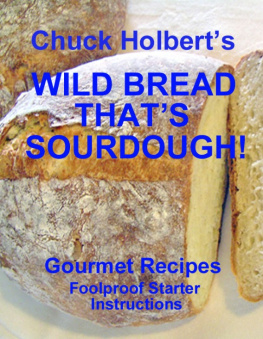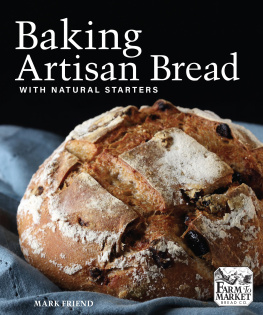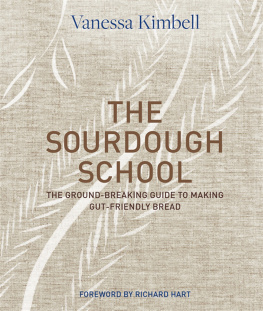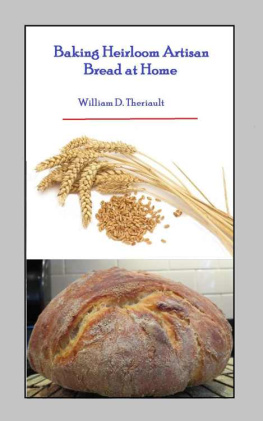The Artisan Bakery School - Baking Real Sourdough Bread
Here you can read online The Artisan Bakery School - Baking Real Sourdough Bread full text of the book (entire story) in english for free. Download pdf and epub, get meaning, cover and reviews about this ebook. year: 2014, publisher: Pendragan, genre: Home and family. Description of the work, (preface) as well as reviews are available. Best literature library LitArk.com created for fans of good reading and offers a wide selection of genres:
Romance novel
Science fiction
Adventure
Detective
Science
History
Home and family
Prose
Art
Politics
Computer
Non-fiction
Religion
Business
Children
Humor
Choose a favorite category and find really read worthwhile books. Enjoy immersion in the world of imagination, feel the emotions of the characters or learn something new for yourself, make an fascinating discovery.
- Book:Baking Real Sourdough Bread
- Author:
- Publisher:Pendragan
- Genre:
- Year:2014
- Rating:5 / 5
- Favourites:Add to favourites
- Your mark:
- 100
- 1
- 2
- 3
- 4
- 5
Baking Real Sourdough Bread: summary, description and annotation
We offer to read an annotation, description, summary or preface (depends on what the author of the book "Baking Real Sourdough Bread" wrote himself). If you haven't found the necessary information about the book — write in the comments, we will try to find it.
Baking Real Sourdough Bread — read online for free the complete book (whole text) full work
Below is the text of the book, divided by pages. System saving the place of the last page read, allows you to conveniently read the book "Baking Real Sourdough Bread" online for free, without having to search again every time where you left off. Put a bookmark, and you can go to the page where you finished reading at any time.
Font size:
Interval:
Bookmark:
by The Artisan Bakery School
All contents copyright Penny Williams and Dragan Matijevic 2013
***
Published by Pendragan Publishing

***
Smashwords Edition
ISBN: 9781311611581
***
This book cannot be copied, reprinted or redistributed for sale by any mechanical, electronic or other means. The design, photographs and text remain the properties of the authors.
The information contained in this text has been verified and documented as carefully as possible. The authors cannot be held liable for the use of its contents.
***
Pendragan Publishing
Old Home Cottage
Sparkwell
Plymouth PL7 5DQ
United Kingdom
First Edition 2013

This section contains recipes for four basic breads: White, Brown, Rye and White with Olive Oil. We recommend choosing organic strong bread flour, and where possible, a heritage variety (see below).
When making sourdough bread giving your dough time to rise is of the essence. You can do this using our Straight Run Schedule or you can use either of the two fridge methods that give plenty of time to the dough, from 12 to 120 hours.
Notes:
Recipe quantities are also shown as percentages so that you can scale the number of loaves you want to bake up or down. The flour weight is always 100% and other ingredients are a percentage of that weight. Water is 65%, Leaven is 25% and salt is 2%. At The Artisan Bakery School, we only use organic flour, sea salt and filtered water (because chlorine in tap water tends to kill the yeast).
If you want to speed your timings you can increase the amount of leaven in the recipes to up to 50%. If you add over 50% you will be facing rapid breakdown of gluten and will have to keep a keen eye on your dough development.
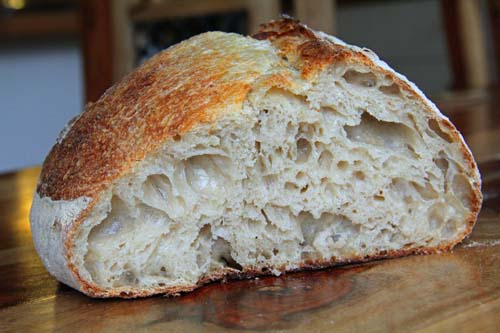
540g - white flour - 3 1/3 cups
100g - leaven - 1/3 cup
350g - water - 1 cups & 2 Tbsp
12g - Salt - 2 tsp
7 Steps to make your leaven:
1. 12 hours before your bread-making session (i.e. the night before), take the starter from the fridge.
2. Take out 20% of your desired leaven quantity.In our recipe for 100g/1/3cup of leaven you would take out 20g/1 Tbsp starter.
3. Replenish the remaining starter and put it back in the fridge. If you took out 20g/1 Tbsp of starter, replace it with 20g/1 Tbsp of water and 20g/1 Tbsp of flour.
4. Make the leaven. This is made of: 20% starter + 40% flour + 40% water.
5. For 100g/1/3cup of leaven, feed your 20g/1 Tbsp starter with 40g/3 Tbsp od water and 40g/4 Tbsp of white flour.
6. Leave the leaven to ripen for about 8-12 hours. You can test by dropping a blob of it in warm water if it floats, its ready. It should be bubbly, smelling sweetly and slightly acidy - almost like yoghurt. (Note: this is the liquid leaven were talking about. A stiff leaven should smell more acidic).
7. Mix your leaven in Step 1 with all the other ingredients to make a dough and follow the rest of the Seven Steps.
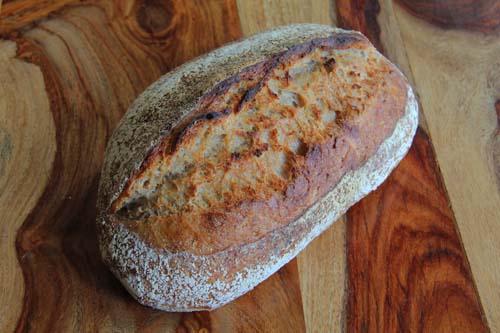
240g - brown flour - 1 & 1/3 cups
300 - white flour - 2 cups
100g - leaven - 1/3 cup
350g - water - 1 cups & 2 Tbsp
12g - Salt - 2 tsp
7 Steps to make your leaven:
1. 12 hours before your bread-making session (i.e. the night before), take the starter from the fridge.
2. Take out 20% of your desired leaven quantity.In our recipe for 100g/1/3cup of leaven you would take out 20g/1 Tbsp starter.
3. Replenish the remaining starter and put it back in the fridge. If you took out 20g/1 Tbsp of starter, replace it with 20g/1 Tbsp of water and 20g/1 Tbsp of flour.
4. Make the leaven. This is made of: 20% starter + 40% flour + 40% water.
5. For 100g/1/3cup of leaven, feed your 20g/1 Tbsp starter with 40g/3 Tbsp od water and 40g/4 Tbsp of white flour.
6. Leave the leaven to ripen for about 8-12 hours. You can test by dropping a blob of it in warm water if it floats, its ready. It should be bubbly, smelling sweetly and slightly acidy - almost like yoghurt. (Note: this is the liquid leaven were talking about. A stiff leaven should smell more acidic).
7. Mix your leaven in Step 1 with all the other ingredients to make a dough and follow the rest of the Seven Steps.
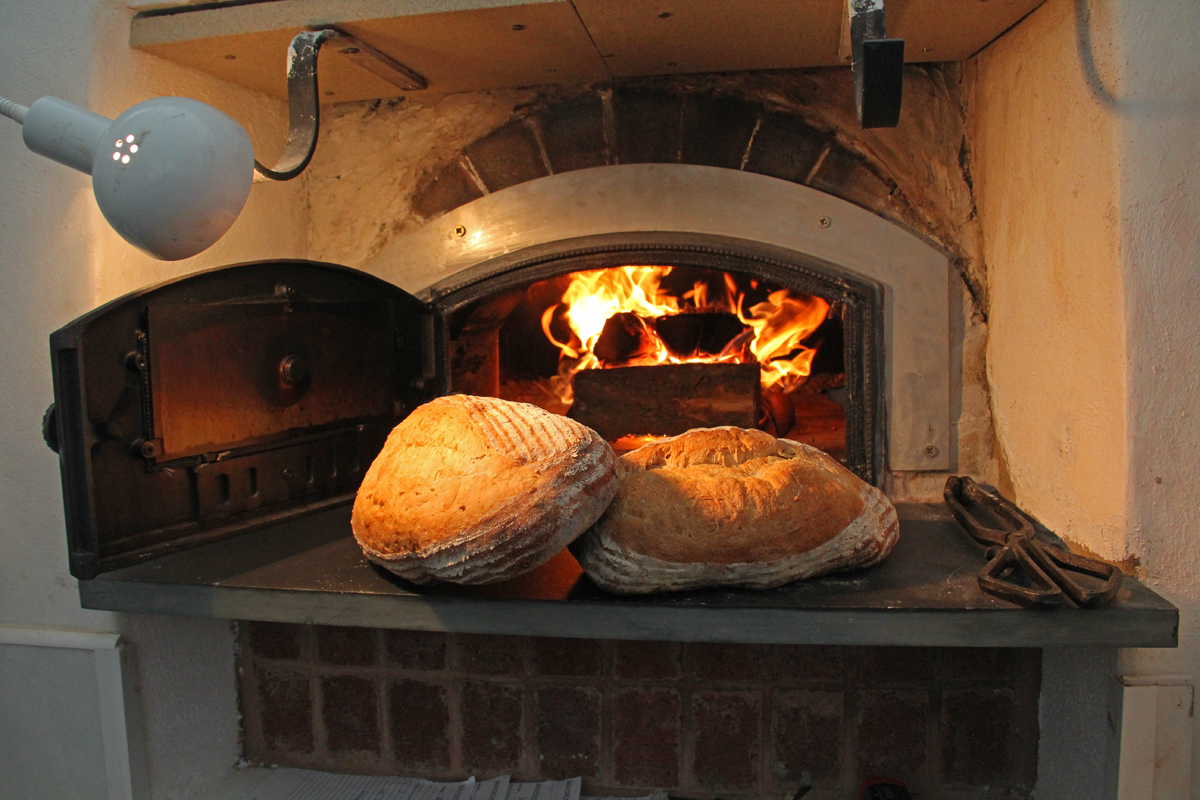
Adding olive oil or pecan oil to your recipes adds taste and softens the gluten (especially good if the flour is of strong variety). You can add anything from 1% to 10%, but 4% is the most common. Like all other additions to basic dough, add oil after you have mixed and kneaded the basic dough (at the end of Step 1). If oil is added at the beginning of mixing process it will coat the gluten strands and will prevent the leaven from working on the dough as well as it should.
540g - white flour - 3 1/3 cups
100g - leaven - 1/3 cup
350g - water - 1 cups & 2 Tbsp
12g - Salt - 2 tsp
30g - Olive Oil - 2 Tbsp
7 Steps to make your leaven:
1. 12 hours before your bread-making session (i.e. the night before), take the starter from the fridge.
2. Take out 20% of your desired leaven quantity. In our recipe for 100g/1/3cup of leaven you would take out 20g/1 Tbsp starter.
3. Replenish the remaining starter and put it back in the fridge. If you took out 20g/1 Tbsp of starter, replace it with 20g/1 Tbsp of water and 20g/1 Tbsp of flour.
4. Make the leaven. This is made of: 20% starter + 40% flour + 40% water.
5. For 100g/1/3cup of leaven, feed your 20g/1 Tbsp starter with 40g/3 Tbsp od water and 40g/4 Tbsp of white flour.
6. Leave the leaven to ripen for about 8-12 hours. You can test by dropping a blob of it in warm water if it floats, its ready. It should be bubbly, smelling sweetly and slightly acidy - almost like yoghurt. (Note: this is the liquid leaven were talking about. A stiff leaven should smell more acidic).
7. Mix your leaven in Step 1 with all the other ingredients to make a dough and follow the rest of the Seven Steps.
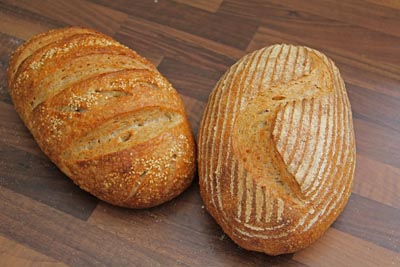
Adding rye creates a rustic loaf similar to the French pain de campagne.
When you add rye to your dough it will make it heavier as rye is low on gluten. If you find 15% rye too much you can try 10% instead. On the other hand you may like adding the rye so much that you can try bigger percentages of up to 30%. (For 100% rye loaf, you will need 100% rye leaven too - see our book Low Gluten Sourdough.)
Here are the proportions with rye flour in them:
80g - rye flour - 1/3 cup
460g - white flour - 3 cups
100g - leaven - 1/3 cup
350g - water - 1 cups & 2 Tbsp
12g - Salt - 2 tsp
7 Steps to make your leaven:
Font size:
Interval:
Bookmark:
Similar books «Baking Real Sourdough Bread»
Look at similar books to Baking Real Sourdough Bread. We have selected literature similar in name and meaning in the hope of providing readers with more options to find new, interesting, not yet read works.
Discussion, reviews of the book Baking Real Sourdough Bread and just readers' own opinions. Leave your comments, write what you think about the work, its meaning or the main characters. Specify what exactly you liked and what you didn't like, and why you think so.

